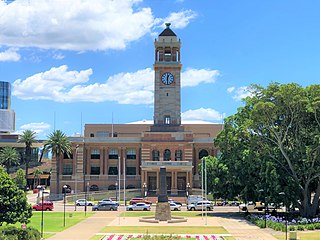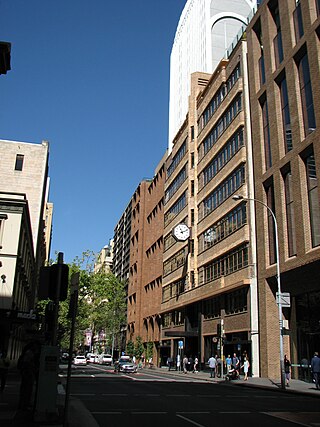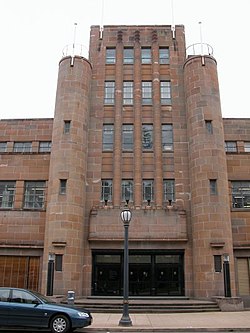
Newcastle, also commonly referred to as Greater Newcastle is a large metropolitan area and the second-most-populous such area of New South Wales, Australia. It includes the cities of Newcastle and Lake Macquarie and it is the hub of the Lower Hunter region, which includes most parts of the cities of Newcastle, Lake Macquarie, Maitland, Cessnock, and Port Stephens Council. Newcastle is also known by its colloquial nickname, Newy.

The Australian War Memorial (AWM) is a national war memorial and museum dedicated to all Australians who died as a result of war. The AWM is located in Campbell, a suburb of the Australian capital of Canberra. The grounds include five buildings and a sculpture garden. Most of the museum galleries and commemorative areas are contained in the Memorial Building.

The Anzac Memorial is a heritage-listed war memorial, museum and monument located in Hyde Park South near Liverpool Street in the CBD of Sydney, Australia. The Art Deco monument was designed by C. Bruce Dellit, with the exterior adorned with monumental figural reliefs and sculptures by Rayner Hoff, and built from 1932 to 1934 by Kell & Rigby. This state-owned property was added to the New South Wales State Heritage Register on 23 April 2010.
Australian non-residential architectural styles are a set of Australian architectural styles that apply to buildings used for purposes other than residence and have been around only since the first colonial government buildings of early European settlement of Australia in 1788.

The Newcastle Civic Theatre, also known as The Civic, is a heritage-listed building located on Hunter Street, Newcastle, Australia. Opened in 1929, the 1520-seat theatre is now the venue for a wide range of musicals, plays, concerts and dance events each year and is the city's oldest surviving theatre.
Archaeological evidence indicates that human beings have inhabited the area around Newcastle, New South Wales for at least 6500 years. In 2009, archaeologist uncovered over 5,534 Aboriginal artefacts, representing three occupation periods. In the 1820s, the Reverend Lancelot Threlkeld worked with local Awabakal man Biraban to record the Awabakal language. Since 1892, the Indigenous people of Newcastle have come to be known as the Awabakal.

Emil Lawrence Sodersten was an Australian architect active in the second quarter of the 20th century. His work encompassed the Australian architectural styles of Art Deco and Functionalist & Moderne. His design for the Australian War Memorial was "the first national architectural monument in Australia". The Australian Institute of Architects presents the Emil Sodersten Interior Architecture Award annually in his honour.

The Newcastle City Hall is a heritage-listed building located in the regional New South Wales city of Newcastle in the Hunter region in Australia. The building served as the city hall for the Council of the City of Newcastle between 1929 and 1977.
David Surrey Gibson Littlemore AO was one of Australia's most distinguished architects. Littlemore was one of the first life fellows of the Royal Australian Institute of Architects. He was head of construction supervision in the consortium Hall Todd & Littlemore appointed by the NSW Government Architect to complete the Sydney Opera House in April 1966 when Mr Jørn Utzon resigned his commission from the NSW Government. Peter Hall was design architect and Lionel Todd was responsible for contract documentation.

Electricity Substation No. 167 is a heritage-listed electrical substation at 93 Parramatta Road, Auburn, Cumberland Council, New South Wales, Australia. It was designed and built from 1924 to 1929 by the Municipal Council of Sydney, with the City Architect being responsible for the design. It is also known as #167 'AUBURN' 33KV ZONE SUBSTATION. The property is owned by Ausgrid. It was added to the New South Wales State Heritage Register on 2 May 2008.

The Scone Civic Theatre is a heritage-listed cinema at 144 Kelly Street, Scone, Upper Hunter Shire, New South Wales, Australia. It was designed by Guy Crick and Bruce Furse and built from 1937 to 1938 by Mr A. F. Little. The property is privately owned. It was added to the New South Wales State Heritage Register on 21 February 2003.

Horbury Hunt Hall is a heritage-listed church hall at 52a Church Street, The Hill, Newcastle, City of Newcastle, New South Wales, Australia. It was designed by John Horbury Hunt and built in 1878. It is also known as Christ Church Anglican Cathedral Hall. The property is owned by the Anglican Diocese of Newcastle. It was added to the New South Wales State Heritage Register on 2 April 1999.

Electricity Substation No. 269 is a heritage-listed electrical substation located at 36 Anglesea Street, Bondi, New South Wales, Australia. It was designed by Walter Frederick White, City Architect's Office and Municipal Council of Sydney and built in 1928 by the Municipal Council of Sydney. The property is owned by Ausgrid. It was added to the New South Wales State Heritage Register on 2 May 2008.

The Electricity Substation No. 349 is a heritage-listed electrical substation at 2S Frances Street, Randwick, New South Wales, Australia. It was designed by Walter Frederick White, City Architect's Department and Municipal Council of Sydney and built during 1930 by J Rutherford. It is also known as #349 Princes Street substation. The property is owned by Ausgrid. It was added to the New South Wales State Heritage Register on 2 May 2008.

Kyle House is a heritage-listed commercial office at 27-31 Macquarie Place, in the Sydney central business district, in the City of Sydney local government area of New South Wales, Australia. It was designed by C. Bruce Dellit and built during 1931 by Stuart Bros. The property is privately owned. It was added to the New South Wales State Heritage Register on 2 April 1999.

AMA House, Sydney or the Australian Medical Association House, Sydney is a heritage-listed former medical office and library and now commercial offices located at 135–137 Macquarie Street in the Sydney central business district, in the City of Sydney local government area of New South Wales, Australia. It was designed by Fowell & McConnel and built from 1929 to 1930 by Messrs Hutcherson Bros. It was formerly known as BMA House or the British Medical Association House. The property is privately owned. It was added to the New South Wales State Heritage Register on 2 April 1999.

Challis House is a heritage-listed commercial building located at 4–10 Martin Place in the Sydney central business district, in the City of Sydney local government area of New South Wales, Australia. The property was added to the New South Wales State Heritage Register on 2 April 1999.

The Trust Building is a heritage-listed office and commercial building and former hotel located at 72-72a Castlereagh Street, in the Sydney central business district, in the City of Sydney local government area of New South Wales, Australia. It was designed by firm Robertson & Marks and built from 1914 to 1916 by Stuart Brothers. It was added to the New South Wales State Heritage Register on 2 April 1999.

The Red Cross House is a heritage-listed former commercial building and now Australian Red Cross and blood transfusion centre located at 153-159 Clarence Street, Sydney, New South Wales, Australia. It was designed by Samuel Lipson, architect, in conjunction with Robertson and Marks and McCredie and built from 1937 to 1938 by Kell & Rigby. It was originally built for the firm of S. Hoffnung & Co.

Newcastle Government House is a heritage-listed former military post and official residence and now park and psychiatric hospital at 72 Watt Street, Newcastle, New South Wales, Australia. It is also known as Newcastle Government House and Domain, Newcastle Military Barracks & Hospital, Newcastle Industrial School for Girls, Reformatory for Girls, Lunatic Asylum for Imbeciles, James Fletcher Hospital and Fletcher Park. It was added to the New South Wales State Heritage Register on 22 March 2011.





















